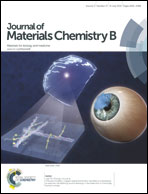Peptide microarrays for the discovery of bioactive surfaces that guide cellular processes: a single step azide–alkyne “click” chemistry approach†
Abstract
Cell behavior in vivo is guided by a complex microenvironment containing many different molecules including extracellular matrix (ECM) proteins, growth factors, and proteoglycans. Controlling the interaction between these various components at the cell–material interface will be invaluable in developing new materials for biomedical devices and tissue engineering applications. We report a single step approach to forming mixed peptide conjugated self-assembled monolayers on gold using copper-catalyzed azide–alkyne cycloaddition chemistry to study the combinatorial effects of different peptide ligands on cellular processes. We synthesized ECM adhesion peptides (YIGSR, GRGDS), a bone morphogenetic protein 7 (BMP-7) derived peptide (KPSSAPTQLN), and a heparin binding peptide (KRSR), and arrayed them, alone and in combination, onto gold coated coverslips. SAMs were characterized by X-ray photoelectron spectroscopy (XPS) and matrix-assisted laser desorption/ionization (MALDI) mass spectrometry, and arrayed peptide combinations were seen to differentially bind to adipose derived stem cells (ADSCs) and mouse embryonic fibroblasts (MEFs). We further investigated the osteogenesis of ADSCs on SAMs containing combinations of adhesion peptide and BMP-7 peptide in both standard culture and osteogenic differentiation media. We demonstrate enhanced expression of osteogenic markers Runx2 and osteopontin when ADSCs are adherent to BMP-7 derived peptide alone or in combination with ECM adhesion peptides. The platform presented here enables immobilization of multiple peptides in a single step using a commercially available microarray spotter which will prove useful in fabricating biomolecule interfaces for cell biology studies and biochemical assays.


 Please wait while we load your content...
Please wait while we load your content...